| SYMBOLS OF THE SEASON 
The Easter Bunny is not a modern invention. The symbol originated with the pagan festival of Eaostre. The goddess, Eaostre, was worshipped by the Anglo-Saxons through her earthly symbol, the rabbit. The Easter bunny has its origin in pre-Christian fertility lore. The hare and the rabbit were the most fertile animals known and they served as symbols of the new life during the spring season. 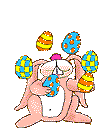
The bunny as an Easter symbol seems to have its origins in Germany, where it was first mentioned in German writings in the 1500s. The first edible Easter bunnies were made in Germany during the early 1800s, made of pastry and sugar. The Easter bunny was introduced to American folklore by the German settlers who arrived in the Pennsylvania Dutch country during the 1700s. The arrival of the Oschter Haws was considered childhood's greatest pleasure next to a visit from Christ-Kindel on Christmas Eve. The children believed that if they were good the Oschter Haws would lay a nest of colored eggs. 
The children would build their nest in a secluded place in the home, the barn or the garden. Boys would use their caps and girls their bonnets to make the nests . The use of elaborate Easter baskets would come later as the tradition of the Easter bunny spread through out the country. The Germans brought the symbol of the Easter rabbit to America. It was widely ignored by other Christians until shortly after the Civil War. In fact, Easter itself was not widely celebrated in America until after that time. As with the Easter Bunny and the holiday itself, the Easter Egg predates the Christian holiday of Easter. The exchange of eggs in the springtime is a custom that was centuries old when Easter was first celebrated by Christians. 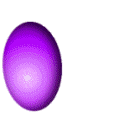
From the earliest times, the egg was a symbol of rebirth in most cultures. Eggs were often wrapped in gold leaf or, if you were a peasant, colored brightly by boiling them with the leaves or petals of certain flowers. Originally Easter eggs were painted with bright colors to represent the sunlight of spring and were used in Easter-egg rolling contests or given as gifts. After they were colored and etched with various designs the eggs were exchanged by lovers and romantic admirers, much the same as valentines. In medieval times eggs were traditionally given at Easter to the servants. In Germany eggs were given to children along with other Easter gifts. Different cultures have developed their own ways of decorating Easter eggs. Crimson eggs, to honor the blood of Christ, are exchanged in Greece. In parts of Germany and Austria green eggs are used on Maundy Thursday (Holy Thursday). Slavic peoples decorate their eggs in special patterns of gold and silver. Austrian artists design patterns by fastening ferns and tiny plants around the eggs, which are then boiled. The plants are then removed revealing a striking white pattern. The Poles and Ukrainians decorate eggs with simple designs and colors. A number of eggs are made in the distinctive manner called pysanki (to design, to write). 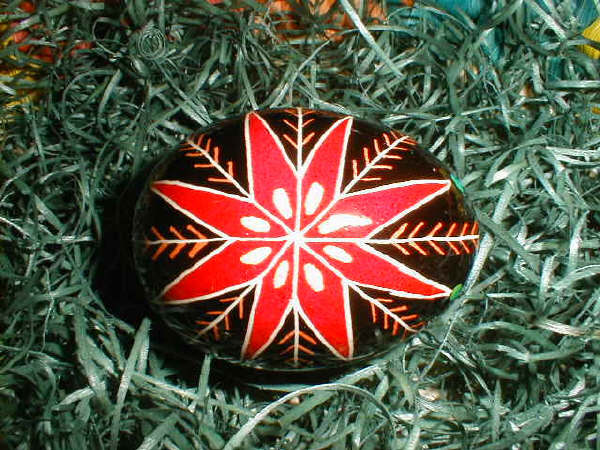
Pysanki eggs are a masterpiece of skill and workmanship. Melted beeswax is applied to the fresh white egg. It is then dipped in successive baths of dye. After each dip wax is painted over the area where the preceding color is to remain. Eventually a complex pattern of lines and colors emerges into a work of art. In Germany and other countries eggs used for cooking where not broken, but the contents were removed by piercing the end of each egg with a needle and blowing the contents into a bowl. The hollow eggs were died and hung from shrubs and trees during the Easter Week. The Armenians would decorate hollow eggs with pictures of Christ, the Virgin Mary, and other religious designs. Eggs play an important part in Easter sports. The Romans celebrated the Easter season by running races on an oval track and giving eggs as prizes. Two traditional Easter egg games are the Easter Egg Hunt and the Easter Egg Roll. The rules of an Easter Egg Roll are to see who can roll an egg the greatest distance or can make the roll without breaking it, usually down a grassy hillside or slope. Maybe the most famous egg rolling takes place on the White House Lawn. Hundreds of children come with baskets filled with brightly decorated eggs and roll them down the famous lawn, hoping the President of the United States is watching the fun. 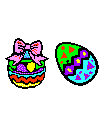
On Easter morning the children of the house join in a search to locate the eggs that the Easter Bunny had hidden while they where asleep. The searching might continue though out the house with the older children helping the youngest. Sometimes prizes of candy are awaiting the child finding the most eggs. Easter egg hunts can are also part of a community's celebration of holiday. The eggs are hidden in public places and the children of the community are invited to find the eggs. Today, children hunt colored eggs and place them in Easter baskets along with the modern version of real Easter eggs -- those made of plastic or chocolate candy. The exact origins of the jelly bean are lost in time, and only a part of its history is known. Most experts believe the jelly center is a descendent of a Mid-Eastern confection known as Turkish Delight that dates back to Biblical times. The shell coating is an offspring of a process called panning, first invented in 17th century France to make Jordan Almonds. The panning process, while done primarily by machine today, has remained essentially the same for the last 300 years. The French began by rocking almonds in a bowl filled with sugar and syrup until the almonds were coated with a candy shell. Today, large rotating pans do the heavy work, while master confectioners apply their true art in adding the ingredients to create just the right shell. Somehow the two processes made their way to America. Jelly beans quickly earned a place among the many glass jars of "penny candy" in general stores where they were sold by weight and taken home in paper bags. It wasn't until the 1930's, however, that jelly beans became a part of Easter traditions. Over 15 billion jelly beans are enjoyed at Eastertime. If they were lined up end-to-end, they would circle the Earth nearly 3 times. 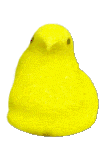
CLICK THE CHICK TO GET TO THE NEXT PAGE! CUTE CHICKA WEBSET BY FOREVER AMBER ANIMATIONS FROM JO'S WORLD |  Free Forum Hosting
Free Forum Hosting